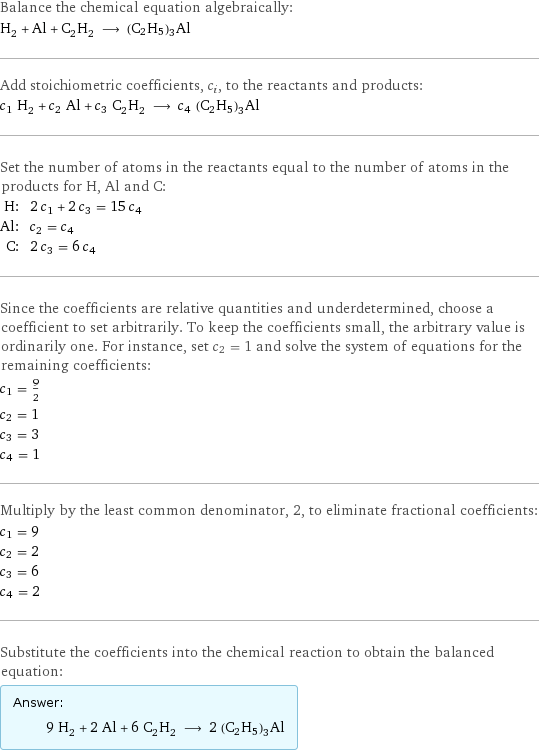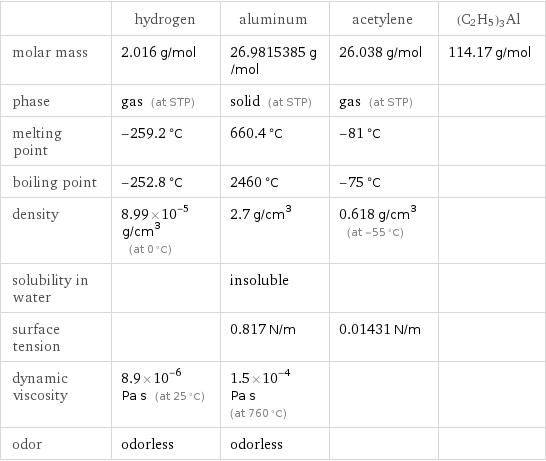Input interpretation

H_2 hydrogen + Al aluminum + C_2H_2 acetylene ⟶ (C2H5)3Al
Balanced equation

Balance the chemical equation algebraically: H_2 + Al + C_2H_2 ⟶ (C2H5)3Al Add stoichiometric coefficients, c_i, to the reactants and products: c_1 H_2 + c_2 Al + c_3 C_2H_2 ⟶ c_4 (C2H5)3Al Set the number of atoms in the reactants equal to the number of atoms in the products for H, Al and C: H: | 2 c_1 + 2 c_3 = 15 c_4 Al: | c_2 = c_4 C: | 2 c_3 = 6 c_4 Since the coefficients are relative quantities and underdetermined, choose a coefficient to set arbitrarily. To keep the coefficients small, the arbitrary value is ordinarily one. For instance, set c_2 = 1 and solve the system of equations for the remaining coefficients: c_1 = 9/2 c_2 = 1 c_3 = 3 c_4 = 1 Multiply by the least common denominator, 2, to eliminate fractional coefficients: c_1 = 9 c_2 = 2 c_3 = 6 c_4 = 2 Substitute the coefficients into the chemical reaction to obtain the balanced equation: Answer: | | 9 H_2 + 2 Al + 6 C_2H_2 ⟶ 2 (C2H5)3Al
Structures

+ + ⟶ (C2H5)3Al
Names

hydrogen + aluminum + acetylene ⟶ (C2H5)3Al
Equilibrium constant
![Construct the equilibrium constant, K, expression for: H_2 + Al + C_2H_2 ⟶ (C2H5)3Al Plan: • Balance the chemical equation. • Determine the stoichiometric numbers. • Assemble the activity expression for each chemical species. • Use the activity expressions to build the equilibrium constant expression. Write the balanced chemical equation: 9 H_2 + 2 Al + 6 C_2H_2 ⟶ 2 (C2H5)3Al Assign stoichiometric numbers, ν_i, using the stoichiometric coefficients, c_i, from the balanced chemical equation in the following manner: ν_i = -c_i for reactants and ν_i = c_i for products: chemical species | c_i | ν_i H_2 | 9 | -9 Al | 2 | -2 C_2H_2 | 6 | -6 (C2H5)3Al | 2 | 2 Assemble the activity expressions accounting for the state of matter and ν_i: chemical species | c_i | ν_i | activity expression H_2 | 9 | -9 | ([H2])^(-9) Al | 2 | -2 | ([Al])^(-2) C_2H_2 | 6 | -6 | ([C2H2])^(-6) (C2H5)3Al | 2 | 2 | ([(C2H5)3Al])^2 The equilibrium constant symbol in the concentration basis is: K_c Mulitply the activity expressions to arrive at the K_c expression: Answer: | | K_c = ([H2])^(-9) ([Al])^(-2) ([C2H2])^(-6) ([(C2H5)3Al])^2 = ([(C2H5)3Al])^2/(([H2])^9 ([Al])^2 ([C2H2])^6)](../image_source/d73a7380635e31d16d3687563f72af0b.png)
Construct the equilibrium constant, K, expression for: H_2 + Al + C_2H_2 ⟶ (C2H5)3Al Plan: • Balance the chemical equation. • Determine the stoichiometric numbers. • Assemble the activity expression for each chemical species. • Use the activity expressions to build the equilibrium constant expression. Write the balanced chemical equation: 9 H_2 + 2 Al + 6 C_2H_2 ⟶ 2 (C2H5)3Al Assign stoichiometric numbers, ν_i, using the stoichiometric coefficients, c_i, from the balanced chemical equation in the following manner: ν_i = -c_i for reactants and ν_i = c_i for products: chemical species | c_i | ν_i H_2 | 9 | -9 Al | 2 | -2 C_2H_2 | 6 | -6 (C2H5)3Al | 2 | 2 Assemble the activity expressions accounting for the state of matter and ν_i: chemical species | c_i | ν_i | activity expression H_2 | 9 | -9 | ([H2])^(-9) Al | 2 | -2 | ([Al])^(-2) C_2H_2 | 6 | -6 | ([C2H2])^(-6) (C2H5)3Al | 2 | 2 | ([(C2H5)3Al])^2 The equilibrium constant symbol in the concentration basis is: K_c Mulitply the activity expressions to arrive at the K_c expression: Answer: | | K_c = ([H2])^(-9) ([Al])^(-2) ([C2H2])^(-6) ([(C2H5)3Al])^2 = ([(C2H5)3Al])^2/(([H2])^9 ([Al])^2 ([C2H2])^6)
Rate of reaction
![Construct the rate of reaction expression for: H_2 + Al + C_2H_2 ⟶ (C2H5)3Al Plan: • Balance the chemical equation. • Determine the stoichiometric numbers. • Assemble the rate term for each chemical species. • Write the rate of reaction expression. Write the balanced chemical equation: 9 H_2 + 2 Al + 6 C_2H_2 ⟶ 2 (C2H5)3Al Assign stoichiometric numbers, ν_i, using the stoichiometric coefficients, c_i, from the balanced chemical equation in the following manner: ν_i = -c_i for reactants and ν_i = c_i for products: chemical species | c_i | ν_i H_2 | 9 | -9 Al | 2 | -2 C_2H_2 | 6 | -6 (C2H5)3Al | 2 | 2 The rate term for each chemical species, B_i, is 1/ν_i(Δ[B_i])/(Δt) where [B_i] is the amount concentration and t is time: chemical species | c_i | ν_i | rate term H_2 | 9 | -9 | -1/9 (Δ[H2])/(Δt) Al | 2 | -2 | -1/2 (Δ[Al])/(Δt) C_2H_2 | 6 | -6 | -1/6 (Δ[C2H2])/(Δt) (C2H5)3Al | 2 | 2 | 1/2 (Δ[(C2H5)3Al])/(Δt) (for infinitesimal rate of change, replace Δ with d) Set the rate terms equal to each other to arrive at the rate expression: Answer: | | rate = -1/9 (Δ[H2])/(Δt) = -1/2 (Δ[Al])/(Δt) = -1/6 (Δ[C2H2])/(Δt) = 1/2 (Δ[(C2H5)3Al])/(Δt) (assuming constant volume and no accumulation of intermediates or side products)](../image_source/ba0ad2efcdd11ce178b34ccb766455bb.png)
Construct the rate of reaction expression for: H_2 + Al + C_2H_2 ⟶ (C2H5)3Al Plan: • Balance the chemical equation. • Determine the stoichiometric numbers. • Assemble the rate term for each chemical species. • Write the rate of reaction expression. Write the balanced chemical equation: 9 H_2 + 2 Al + 6 C_2H_2 ⟶ 2 (C2H5)3Al Assign stoichiometric numbers, ν_i, using the stoichiometric coefficients, c_i, from the balanced chemical equation in the following manner: ν_i = -c_i for reactants and ν_i = c_i for products: chemical species | c_i | ν_i H_2 | 9 | -9 Al | 2 | -2 C_2H_2 | 6 | -6 (C2H5)3Al | 2 | 2 The rate term for each chemical species, B_i, is 1/ν_i(Δ[B_i])/(Δt) where [B_i] is the amount concentration and t is time: chemical species | c_i | ν_i | rate term H_2 | 9 | -9 | -1/9 (Δ[H2])/(Δt) Al | 2 | -2 | -1/2 (Δ[Al])/(Δt) C_2H_2 | 6 | -6 | -1/6 (Δ[C2H2])/(Δt) (C2H5)3Al | 2 | 2 | 1/2 (Δ[(C2H5)3Al])/(Δt) (for infinitesimal rate of change, replace Δ with d) Set the rate terms equal to each other to arrive at the rate expression: Answer: | | rate = -1/9 (Δ[H2])/(Δt) = -1/2 (Δ[Al])/(Δt) = -1/6 (Δ[C2H2])/(Δt) = 1/2 (Δ[(C2H5)3Al])/(Δt) (assuming constant volume and no accumulation of intermediates or side products)
Chemical names and formulas

| hydrogen | aluminum | acetylene | (C2H5)3Al formula | H_2 | Al | C_2H_2 | (C2H5)3Al Hill formula | H_2 | Al | C_2H_2 | C6H15Al name | hydrogen | aluminum | acetylene | IUPAC name | molecular hydrogen | aluminum | acetylene |
Substance properties

| hydrogen | aluminum | acetylene | (C2H5)3Al molar mass | 2.016 g/mol | 26.9815385 g/mol | 26.038 g/mol | 114.17 g/mol phase | gas (at STP) | solid (at STP) | gas (at STP) | melting point | -259.2 °C | 660.4 °C | -81 °C | boiling point | -252.8 °C | 2460 °C | -75 °C | density | 8.99×10^-5 g/cm^3 (at 0 °C) | 2.7 g/cm^3 | 0.618 g/cm^3 (at -55 °C) | solubility in water | | insoluble | | surface tension | | 0.817 N/m | 0.01431 N/m | dynamic viscosity | 8.9×10^-6 Pa s (at 25 °C) | 1.5×10^-4 Pa s (at 760 °C) | | odor | odorless | odorless | |
Units
